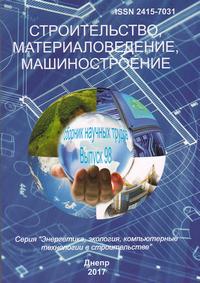Simulation of initiation of methane explosion shock wave forecast as safety assessment
Keywords:
shock air wave, gas-air mixture, initiation, numerical calculation, combustion front, reaction promotion.Abstract
Abstract. Purpose. Increase the safety of work in explosive and fire hazardous areas by establishing the patterns of initiation of airgas mixtures by a shock air wave and their consideration in risk assessment and development of measures to reduce them. Mathematical modeling of the passage of a direct and reflected shock air wave through local accumulations of methane. Methodology. Based on the analysis of known studies on the mathematical modeling of explosive processes in a gaseous medium, the task is to study the process of initiating the explosion of a gas-air mixture by a shock air wave. The problem is solved by performing a numerical experiment of propagation of a shock air wave through a cloud of a gas-air mixture. Results. The solution of the problem is made using the mathematical model of the shock tube. The calculation technique in this model is based on the joint solution of the equations of gas dynamics and the chemical kinetics of combustion of a methane-oxygen mixture in air by a numerical method. To describe the motion of the medium in a cylindrical coordinate system, the Euler equations (in the divergent form) were used, which are usually used in calculating the flow of a compressible ideal gas and allow discontinuous solutions. The chemical reaction is presented in the form of one gross-scheme (generalized kinetic mechanism). The reaction rate and, accordingly, the heat release were calculated by the Arrhenius equation. The scheme well describes both own and available in the literature experimental data on the ignition of methane in shock waves in the range of excess pressure in the front of the shock wave from 1.4 to 3 MPa. Scientific novelty. Visible initiation effects have shown a strong influence of gas dynamics on the kinetics of chemical reactions of explosive combustion, which corresponds to the thermal mechanism of ignition and the transition of combustion to detonation. Practical value. Numerical experiments revealed regularities in the initiation of local methane accumulations, which make it possible to increase the efficiency of the method for calculating safe distances and shock loads on building structures during emergency explosions.References
Mishuev, A.V., Kazenov, V.V. and Komarov, A.A. (2012), Osobennosti avariynyih vzryivov vnutri zhilyih gazifitsirovannyih zdaniy i promyishlennyih ob'ektov [Features of emergency explosions inside residential gasified buildings and industrial facilities], Pozharovzryivobezopasnost, no. 3. pp. 49-56. (in Russian).
Komarov, A.A. (2012), Osnovyi obespecheniya vzryivobezopasnosti ob'ektov i prilegayuschih k nim territoriy [Basics of ensuring explosion safety of facilities and adjacent territories], Academy of the Ministry of Emergency Situations, Moscow, Russia. (in Russian).
Ponyaev, S.A., Apevalov, I.V. and Lebedev, A.S. (2013), Modelirovanie protsessov zaderzhki podzhiga smesi metanvozduh udarnoy volnoy [Simulation process ignition delay methane-air shock wave], Trudyi voenno-kosmicheskoy akademii imeni A.F. Mozhayskogo, vol. 641, pp. 61-68. (in Russian).
Huang, J., Hill, P.G., Bushe, W.K. and Munshi, S.R. (2004), “Shock-tube study of methane ignition under engine-relevant conditions: experiments and modeling”, Combustion and Flame, vol. 136, iss. 1-2, January, рр. 25-42.
Petersen, E.L., Davidson, D.F. and Hanson, R.K. (1999), “Kinetics modeling of shock-induced ignition in low-dilution CH4/O2 mixtures at high pressures and intermediate temperatures”, Combustion and Flame, vol. 117, iss. 1–2, April, pp. 272-290.
Golovastov, S.V. (2008), “Process control ignition and detonation in gas media”, D. Sc. Thesis dissertation, Thermal physics and theoretical heat, Joint Institute for High Temperatures of the Russian Academy of Sciences, Moscow, Russia. (in Russian).
Agafonov, G.L. (2015), Vosplamenenie propana v udarnyih volnah [Ignition of propane in shock waves], Russian Journal of Physical Chemistry B Focus on Physics, Vol. 34, no. 2, pp. 49-60. (in Russian).
Gelfand, B.E., Popov, O.E. and Chayvanov B.B. (2008), Vodorod. Parametryi goreniya i vzryiva [Hydrogen. The parameters of combustion and explosion], Fizmatlit, Moscow, Russia. (in Russian).
Kalyakin, S.A. (2012), Opredelenie kriticheskih parametrov udarnyih voln pri vzryive zaryada VV, vyizyivayuschih vosplamenenie metanovozdushnoy smesi [Determination of the critical parameters of shock waves in the explosion of the explosive charge, causing inflammation of methane-air mixture], Naukovi pratsi DonNTU. Seriya «Hirnychoheolohichna», Issue 16(206), pp. 133-139. (in Russian).
Downloads
Published
Issue
Section
License
Редакція Видання категорично засуджує прояви плагіату в статтях та вживає всіх можливих заходів для його недопущення. Плагіат розглядається як форма порушення авторських прав і наукової етики.
При виявлені у статті більш ніж 25% запозиченого тексту без відповідних посилань та використання лапок, стаття кваліфікується як така, що містить плагіат. У цьому випадку стаття більше не розглядається редакцією, а автор отримує перше попередження.
Автори, в статтях яких повторно виявлено плагіат, не зможуть публікуватися в усіх журналах Видавництва ДВНЗ «Придніпровська державна академія будівництва та архітектури».
Автори, які публікуються у цьому журналі, погоджуються з наступними умовами:
- Автори залишають за собою право на авторство своєї роботи та передають журналу право першої публікації цієї роботи на умовах ліцензії Creative Commons Attribution License, котра дозволяє іншим особам вільно розповсюджувати опубліковану роботу з обов'язковим посиланням на авторів оригінальної роботи та першу публікацію роботи у цьому журналі.
- Автори мають право укладати самостійні додаткові угоди щодо неексклюзивного розповсюдження роботи у тому вигляді, в якому вона була опублікована цим журналом (наприклад, розміщувати роботу в електронному сховищі установи або публікувати у складі монографії), за умови збереження посилання на першу публікацію роботи у цьому журналі.
- Політика журналу дозволяє і заохочує розміщення авторами в мережі Інтернет (наприклад, у сховищах установ або на особистих веб-сайтах) рукопису роботи, як до подання цього рукопису до редакції, так і під час його редакційного опрацювання, оскільки це сприяє виникненню продуктивної наукової дискусії та позитивно позначається на оперативності та динаміці цитування опублікованої роботи (див. The Effect of Open Access).

